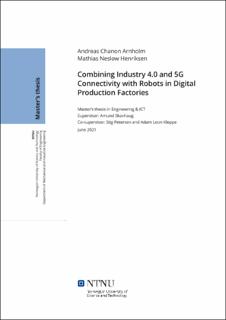| dc.contributor.advisor | Skavhaug, Amund | |
| dc.contributor.author | Arnholm, Andreas Chanon | |
| dc.contributor.author | Henriksen, Mathias Neslow | |
| dc.date.accessioned | 2021-10-13T17:28:14Z | |
| dc.date.available | 2021-10-13T17:28:14Z | |
| dc.date.issued | 2021 | |
| dc.identifier | no.ntnu:inspera:78072783:24569411 | |
| dc.identifier.uri | https://hdl.handle.net/11250/2799895 | |
| dc.description.abstract | Denne masteroppgaven undersøker om 5G kan komplementere og brukes som en del av eller i forbindelse med de andre store industrielle drivkreftene i dag, hovedsakelig Industri 4.0-initiativer som Asset Administration Shells. Dette gjøres i lys av to «use case»-er som er foreslått av 5G-SOLUTIONS-prosjektet, som begge tar sikte på å videreutvikle digitale fabrikker med både avanserte kommunikasjonsløsninger og sanntidsfjernstyring. En arkitektur er designet og foreslått som en måte å takle «use case»-ene på. Implementasjonen av denne arkitekturen er et system med et tilhørende AAS, som bruker 5G-kommunikasjon, OPC UA og ROS 2. Funksjonaliteten til systemet dreier seg om auto-/re-konfigurasjon, rask utrulling og distribusjon, og fjernstyring av en AGV. Oppgaven presenterer arbeidet som er utført for å sette opp et testmiljø ved NTNU Gløshaugen’s Industri 4.0 laboratorium, samt den faktiske tilnærmingen til implementering av systemet basert på den foreslåtte arkitekturen. Hver komponent i systemet blir grundig diskutert i lys av Industri 4.0-standarder, og gjennomførbarheten av dem blir vurdert med hensyn til «use case»-ene. Resultatene av dette blir brukt i et forsøk på å bestemme systemets og 5Gs verdi i et industrielt miljø basert på Industri 4.0-initiativer. Det endelige målet med å utvikle et system som oppfyller standardene for brukstilfellene og Industri 4.0 er delvis oppnådd. Et betydelig forskningsunderlag og en komponentbasert arkitektur er etablert og testet på mange nivåer. Systemet med AAS-en brukes til å kontrollere en AGV eksternt, over internett og med bruk av 5G. Rask utrulling og auto-/re-konfigurasjon er testet og funnet sannsynlig. Systemet støtter til en viss grad ideen om å få en ny robot introdusert til en fabrikk eller laboratorium og testet innen kort tid. Den aksepterte maksimum forsinkelsen som kreves av et Industri 4.0-kompatibelt sanntidsrobotsystem oppnås ikke, noe som delvis skyldes eksterne forsinkelser knyttet til installasjonen av en lokal 5G-node ved NTNU Gløshaugens Industri 4.0-laboratorium. | |
| dc.description.abstract | This thesis explores whether 5G can complement and be used as part of or in conjunction with today's other major industrial driving forces, mainly Industry 4.0 initiatives such as Asset Administration Shells. This is done in light of two use cases proposed by the 5G-SOLUTIONS project, both of which aim to further develop digital factories with advanced communication solutions and real-time, remote operation. An architecture is designed and proposed as a way to tackle the use cases. The implementation of this architecture is a system with an accompanying AAS, which utilizes 5G communication, OPC UA, and ROS 2. The system's functionality revolves around auto/re-configuration, rapid deployment, and remote control of an AGV. The thesis presents the work carried out for setting up a testing environment at NTNU Gløshaugen's Industry 4.0 laboratory and the fundamental approach to implementing the system based on the proposed architecture. Each component in the system is thoroughly discussed in light of Industry 4.0 standards, and their feasibility is reviewed with regard to the use cases. The results of this are used to determine the system's and 5G's feasibility in an industrial environment based on Industry 4.0 initiatives. The end goal of developing a system meeting the standards of the use cases and Industry 4.0 is partly accomplished. A substantial research foundation and a component-based architecture are established and tested on many levels. The system with the AAS is used to control an AGV remotely, over the internet, and with the use of 5G. Rapid deployment and auto/re-configuration are tested and found plausible. To some extent, the system does support the idea of getting a new robot introduced to a factory or laboratory and tested within a short amount of time. The latency results required by an Industry 4.0-compliant real-time robotic system are not achieved, which is partly due to external delays associated with the installation of a local 5G node at NTNU Gløshaugen's Industry 4.0 laboratory. | |
| dc.language | eng | |
| dc.publisher | NTNU | |
| dc.title | Combining Industry 4.0 and 5G Connectivity with Robots in Digital Production Factories | |
| dc.type | Master thesis | |
